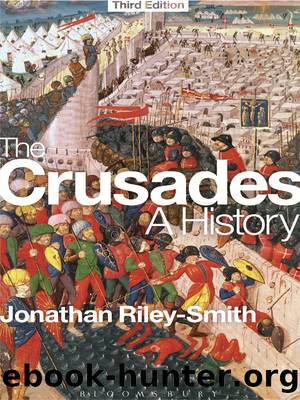The Crusades: A History by Jonathan Riley-Smith

Author:Jonathan Riley-Smith [Riley-Smith, Jonathan]
Language: eng
Format: epub
Publisher: Bloomsbury Publishing
Published: 2014-02-25T00:00:00+00:00
The Childrenâs Crusade
The picture we have of crusading in 1212 is panoramic, although not on the scale of 1147â50. War was being waged on three fronts â along the Baltic coast, in Languedoc and in Iberia â but there was relative peace in the East where in 1211 the kingdom of Jerusalem had made a six-year truce with the Muslims. At this inopportune moment there erupted a popular movement dedicated to saving the Holy Land. It was to be the first of the spasms of mass fervour that punctuated the thirteenth and early fourteenth centuries. These upheavals, the so-called âpopular crusadesâ, were manifestations of the frustration of the poor. Armies for the Eastern theatre were increasingly being transported by sea, which meant that the masses could no longer afford to go with them. It was one thing to join a force marching overland â all one needed was health and the use of oneâs legs â but it was quite another to find the money to pay for a maritime passage.
During the previous winter northern France and the Rhineland had been in ferment, as preaching for the Albigensian Crusade fired popular enthusiasm. Hysteria was generated further by the news from Spain of the loss of the castle of Salvatierra and by the penitential processions that were organized by the clergy. Gary Dickson has convincingly established the course of events that followed. One of the processions, which took place in Chartres on 20 May 1212, was witnessed by a shepherd boy from the village of Cloyes called Stephen. Inspired by his experience, Stephen believed that on his return home he was visited by Christ, dressed as a pilgrim, who gave him a letter to be presented to the king of France. His account of his vision â and probably his own charisma â triggered an uprising of peasants, many of whom appear to have been young. They were probably adolescents, rather than small children, and they were joined by adults as well. A crowd chanting, âLord God, exalt Christianity! Restore the True Cross to us!â, which was estimated at between 15,000 and 30,000 men and women, followed Stephen to St Denis, on the outskirts of Paris, in the vain hope of meeting the king.
They were told to go home. Many of them seem to have dispersed and Stephen is not heard of again. The rest marched through northern France to Cologne, where their arrival in late July sparked another uprising, under a young leader called Nicholas. Still numbering several thousand, the group journeyed to Italy, making for the coast from which they hoped to cross the Mediterranean dry shod. Disappointed at Genoa, some went on westward to Marseille and others to Rome where they were turned back.
A mass movement among âchildrenâ fired the imagination of contemporaries and within 30 years the story was being mythologized. It was said that Nicholas enrolled in the Fifth Crusade and that some of those who reached Marseille were deceived by two merchants into embarking on
Download
This site does not store any files on its server. We only index and link to content provided by other sites. Please contact the content providers to delete copyright contents if any and email us, we'll remove relevant links or contents immediately.
Winning the War in Your Mind by Craig Groeschel(540)
A World Ablaze by Craig Harline(505)
White Too Long by Robert P. Jones(470)
Beautiful Resistance: The Joy of Conviction in a Culture of Compromise by Jon Tyson(464)
The Mission by David W. Brown(460)
History of the Church by Eusebius(458)
In the Reign of King John by Dan Jones(457)
No More Christian Nice Guy by Paul Coughlin(430)
The Crusades: A History by Jonathan Riley-Smith(400)
Why Study History? by John Fea(387)
The Black Church by Henry Louis Gates Jr(372)
The Tale of the Tardy Oxcart (Swindoll Leadership Library) by Swindoll Charles R(371)
Three Messiahs : The Historical Judas the Galilean, the Revelatory Christ Jesus, and the Mythical Jesus of Nazareth (9781450259477) by Unterbrink Daniel T(367)
The History of Palestine by John Kitto(351)
A Spacious Life by Ashley Hales(346)
Assassination of a Saint by Eisenbrandt Matt(338)
Augustine of Canterbury by Robin Mackintosh;(323)
Border Lines: The Partition of Judaeo-Christianity (Divinations: Rereading Late Ancient Religion) by Daniel Boyarin(320)
The Zionist Bible (BibleWorld) by Masalha Nur(316)
